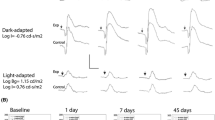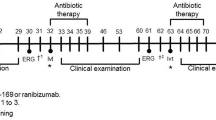Abstract
Background
Tumor necrosis factor (TNF) is known to play an important role in various immune-mediated ocular diseases; intravenous administration of the anti-TNF monoclonal antibody infliximab has proved beneficial in such cases. Since intravitreal injection (when available) is a substitute for systemic administration of various drugs targeting the eye, we aimed to evaluate the safety of intravitreal injection of infliximab in the rabbit eye.
Methods
Seven groups of New Zealand white rabbits (four animals in each group) received a single unilateral intravitreal injection (0.1 ml) of increasing doses of infliximab (namely 1, 2, 5, 8, 10 or 20 mg infliximab [Remicade]) or a sham injection respectively. Slit-lamp biomicroscopy, fundoscopy and electrophysiology recordings, i.e. scotopic, photopic and flicker responses, were performed at baseline and after 1, 5, 10, 15, 30 and 45 days. Infliximab-injected eyes were compared with sham-injected and with uninjected fellow eyes (n = 28). Animals were euthanized on day 45 for histopathological examination of the retinas.
Results
Clinical examination and electrophysiological testing were consistently unremarkable after either sham or 1 mg or 2 mg infliximab injections. In contrast, electrophysiological recordings were significantly reduced in a dose-dependent manner from day 1 through day 45, after 5, 8, 10 and 20 mg infliximab injections. Flicker responses were the most sensitive in detecting the lower toxic dose of 5 mg. Histopathological findings were similar in uninjected and sham-injected eyes, as well as after 1 mg or 2 mg infliximab injections. Consistent with the functional abnormalities, retinal deformities and diffuse edema were observed after injection of 5 mg or higher doses of infliximab.
Conclusions
Intravitreal infliximab may be safely administered up to a dose of 2 mg in the rabbit eye. Such doses can be used in the design of future clinical trials assessing the effects of infliximab for selected patients with immune-mediated ocular conditions.


Similar content being viewed by others
References
Theodossiadis PG, Markomichelakis NN, Sfikakis PP (2007) Tumor necrosis factor antagonists: preliminary evidence for an emerging approach in the treatment of ocular inflammation. Retina 27:399–413, doi:10.1097/MAJ.0b013e3180318fbc
Majka S, McGuire PG, Das A (2002) Regulation of matrix metalloproteinase expression by tumor necrosis factor in a murine model of retinal neovascularization. Invest Ophthalmol Vis Sci 43:260–266
Spranger J, Meyer-Schwickerath R, Klein M, Schatz H, Pfeiffer A (1995) TNF-alpha level in the vitreous body. Increase in neovascular eye diseases and proliferative diabetic retinopathy. Med Klin (Munich) 90:134–137
Ueda T, Ueda T, Fukuda S, Browne R, Jenis E, Spengler R, Chou R, Buch P, Aljada A, Dandona P, Sasisekharan R, Dorey CK, Armstrong D (1998) Lipid hydroperoxide-induced tumor necrosis factor (TNF)-alpha, vascular endothelial growth factor and neovascularization in the rabbit cornea: effect of TNF inhibition. Angiogenesis 1:174–184, doi:10.1023/A:1018377621102
Armstrong D, Augustin AJ, Spengler R, Al-Jada A, Nickola T, Grus F, Koch F (1998) Detection of vascular endothelial growth factor and tumor necrosis factor alpha in epiretinal membranes of proliferative diabetic retinopathy, proliferative vitreoretinopathy and macular pucker. Ophthalmologica 212:410–414, doi:10.1159/000027378
Oh H, Takagi H, Takagi C, Suzuma K, Otani A, Ishida K, Matsumura M, Ogura Y, Honda Y (1999) The potential angiogenic role of macrophages in the formation of choroidal neovascular membranes. Invest Ophthalmol Vis Sci 40:1891–1898
Yang P, McKay BS, Allen JB, Jaffe GJ (2004) Effect of NF-kappa B inhibition on TNF-alpha-induced apoptosis in human RPE cells. Invest Ophthalmol Vis Sci 45:2438–2446, doi:10.1167/iovs.03–0805
Yang P, Wiser JL, Peairs JJ, Ebright JN, Zavodni ZJ, Bowes Rickman C, Jaffe GJ (2005) Human RPE expression of cell survival factors. Invest Ophthalmol Vis Sci 46:1755–1764, doi:10.1167/iovs.04–1039
Santos Lacomba M, Marcos Martin C, Gallardo Galera JM, Gomez Vidal MA, Collantes Estevez E, Ramirez Chamond R, Omar M (2001) Aqueous humor and serum tumor necrosis factor-alpha in clinical uveitis. Ophthalmic Res 33:251–255, doi:10.1159/000055677
Murray PI, Sivaraj RR (2005) Anti-TNF-alpha therapy for uveitis: Behcet and beyond. Eye 19:831–833 doi:10.1038/sj.eye.6701792
Nussenblatt R (2005) Treating intraocular inflammatory disease in the 21st century. Arch Ophthalmol 123:1000–1001, doi:10.1001/archopht.123.7.1000
El-Shabrawi Y, Hermann J (2002) Anti-tumor necrosis factor-alpha therapy with infliximab as an alternative to corticosteroids in the treatment of human leukocyte antigen B27-associated acute anterior uveitis. Ophthalmology 109:2342–2346, doi:10.1016/S0161–6420(02)01292–7
Fries W, Giofre MR, Catanoso M, Lo Gullo R (2002) Treatment of acute uveitis associated with Crohn’s disease and sacroileitis with infliximab. Am J Gastroenterol 97:499–500, doi:10.1111/j.1572–0241.2002.05514.x
Kahn P, Weiss M, Imundo LF, Levy DM (2006) Favorable response to high-dose infliximab for refractory childhood uveitis. Ophthalmology 113:860–864, e862
Sfikakis PP, Theodossiadis PG, Katsiari CG, Kaklamanis P, Markomichelakis NN (2001) Effect of infliximab on sight-threatening panuveitis in Behcet’s disease. Lancet 358:295–296, doi:10.1016/S0140–6736(01)05497–6
Ohno S, Nakamura S, Hori S, Shimakawa M, Kawashima H, Mochizuki M, Sugita S, Ueno S, Yoshizaki K, Inaba G (2004) Efficacy, safety, and pharmacokinetics of multiple administration of infliximab in Behcet’s disease with refractory uveoretinitis. J Rheumatol 31:1362–1368
Sfikakis PP, Kaklamanis PH, Elezoglou A, Katsilambros N, Theodossiadis PG, Papaefthimiou S, Markomichelakis N (2004) Infliximab for recurrent, sight-threatening ocular inflammation in Adamantiades-Behcet disease. Ann Intern Med 140:404–406
Tugal-Tutkun I, Mudun A, Urgancioglu M, Kamali S, Kasapoglu E, Inanc M, Gul A (2005) Efficacy of infliximab in the treatment of uveitis that is resistant to treatment with the combination of azathioprine, cyclosporine, and corticosteroids in Behcet’s disease: an open-label trial. Arthritis Rheum 52:2478–2484, doi:10.1002/art.21231
Baughman RP, Bradley DA, Lower EE (2005) Infliximab in chronic ocular inflammation. Int J Clin Pharmacol Ther 43:7–11
Roberts SD, Wilkes DS, Burgett RA, Knox KS (2003) Refractory sarcoidosis responding to infliximab. Chest 124:2028–2031, doi:10.1378/chest.124.5.2028
Katz JM, Bruno MK, Winterkorn JM, Nealon N (2003) The pathogenesis and treatment of optic disc swelling in neurosarcoidosis: a unique therapeutic response to infliximab. Arch Neurol 60:426–430, doi:10.1001/archneur.60.3.426
Markomichelakis NN, Theodossiadis PG, Pantelia E, Papaefthimiou S, Theodossiadis GP, Sfikakis PP (2004) Infliximab for chronic cystoid macular edema associated with uveitis. Am J Ophthalmol 138:648–650, doi:10.1016/j.ajo.2004.04.066
Sfikakis PP, Markomichelakis N, Theodossiadis GP, Grigoropoulos V, Katsilambros N, Theodossiadis PG (2005) Regression of sight-threatening macular edema in type 2 diabetes following treatment with the anti-tumor necrosis factor monoclonal antibody infliximab. Diabetes Care 28:445–447, doi:10.2337/diacare.28.2.445
Olson JL, Courtney RJ, Mandava N (2007) Intravitreal infliximab and choroidal neovascularization in an animal model. Arch Ophthalmol 125:1221–1224, doi:10.1001/archopht.125.9.1221
Shi X, Semkova I, Muther PS, Dell S, Kociok N, Joussen AM (2006) Inhibition of TNF-alpha reduces laser-induced choroidal neovascularization. Exp Eye Res 83:1325–1334, doi:10.1016/j.exer.2006.07.007
Markomichelakis NN, Theodossiadis PG, Sfikakis PP (2005) Regression of neovascular age-related macular degeneration following infliximab therapy. Am J Ophthalmol 139:537–540, doi:10.1016/j.ajo.2004.09.058
Sfikakis PP, Iliopoulos A, Elezoglou A, Kittas C, Stratigos A (2005) Psoriasis induced by anti-tumor necrosis factor therapy: a paradoxical adverse reaction. Arthritis Rheum 52:2513–2518, doi:10.1002/art.21233
Suhler EB, Smith JR, Wertheim MS, Lauer AK, Kurz DE, Pickard TD, Rosenbaum JT (2005) A prospective trial of infliximab therapy for refractory uveitis: preliminary safety and efficacy outcomes. Arch Ophthalmol 123:903–912, doi:10.1001/archopht.123.7.903
Wegscheider BJ, El-Shabrawi L, Weger M, Ardjomand N, Hermann J, Aberer E, El-Shabrawi Y (2007) Adverse skin reactions to infliximab in the treatment of intraocular inflammation. Eye 21:547–549
Keystone EC (2005) Safety of biologic therapies—an update. J Rheumatol Suppl 74:8–12
Jager RD, Aiello LP, Patel SC, Cunningham ET Jr (2004) Risks of intravitreous injection: a comprehensive review. Retina 24:676–698, doi:10.1097/00006982–200410000–00002
van Norren D, Padmos P (1975) Cone dark adaptation: the influence of halothane anesthesia. Invest Ophthalmol 14:212–227
Marmor MF, Holder GE, Seeliger MW, Yamamoto S (2004) Standard for clinical electroretinography (2004 update). Doc Ophthalmol 108:107–114, doi:10.1023/B:DOOP.0000036793.44912.45
Kivilcim M, Peyman GA, Kazi AA, Dellacroce J, Ghobrial RN, Monzano R (2007) Intravitreal toxicity of high-dose etanercept. J Ocul Pharmacol Ther 23:57–62, doi:10.1089/jop.2006.0083
Manzano RP, Peyman GA, Carvounis PE, Kivilcim M, Khan P, Chevez-Barrios P, Takahashi W (2008) Ocular toxicity of intravitreous adalimumab (Humira) in the rabbit. Graefes Arch Clin Exp Ophthalmol 246:907–911, doi:10.1007/s00417–008–0765-z
Fauser S, Kalbacher H, Alteheld N, Koizumi K, Krohne TU, Joussen AM (2004) Pharmacokinetics and safety of intravitreally delivered etanercept. Graefes Arch Clin Exp Ophthalmol 242:582–586, doi:10.1007/s00417–004–0895-x
Porciatti V, Moretti G, Ciavarella P, Falsini B (1993) The second harmonic of the electroretinogram to sinusoidal flicker: spatiotemporal properties and clinical application. Doc Ophthalmol 84:39–46, doi:10.1007/BF01203281
Shahar J, Avery RL, Heilweil G, Barak A, Zemel E, Lewis GP, Johnson PT, Fisher SK, Perlman I, Loewenstein A (2006) Electrophysiologic and retinal penetration studies following intravitreal injection of bevacizumab (Avastin). Retina 26:262–269, doi:10.1097/00006982–200603000–00002
Giansanti F, Ramazzotti M, Vannozzi L, Rapizzi E, Fiore T, Iaccheri B, Degl’ Innocenti D, Moncini D, Menchini U (2008) A pilot study on ocular safety of intravitreal infliximab in a rabbit model. Invest Ophthalmol Vis Sci 49:1151–1156, doi:10.1167/iovs.07–0932
Author information
Authors and Affiliations
Corresponding author
Additional information
The authors have no financial disclosure regarding this manuscript. All the authors have full control of all primary data, and agree to allow Graefe’s Archive for Clinical and Experimental Ophthalmology to review all data if requested. Every procedure involving animals was conducted in accordance with the Declaration of Helsinki and the ARVO guidelines, and Council Directive 86/609/EEC of 24–11–1986 of the European Union, as well as Greek laws and regulations (Presidential Decree 160/1991, Act No 2015/2001) regarding the protection of animals used for experimental and other scientific purposes. The experimental protocol was approved by the Ethics Committee of “Attikon” University Hospital.
Rights and permissions
About this article
Cite this article
Theodossiadis, P.G., Liarakos, V.S., Sfikakis, P.P. et al. Intravitreal administration of the anti-TNF monoclonal antibody Infliximab in the rabbit. Graefes Arch Clin Exp Ophthalmol 247, 273–281 (2009). https://doi.org/10.1007/s00417-008-0967-4
Received:
Revised:
Accepted:
Published:
Issue Date:
DOI: https://doi.org/10.1007/s00417-008-0967-4




